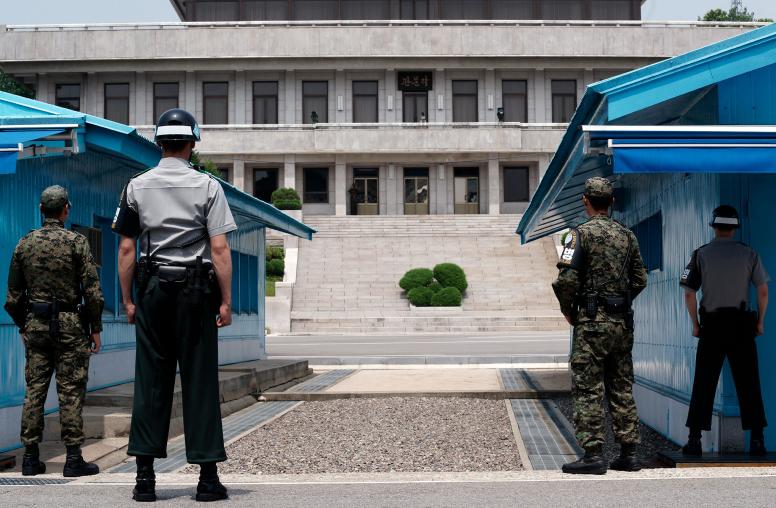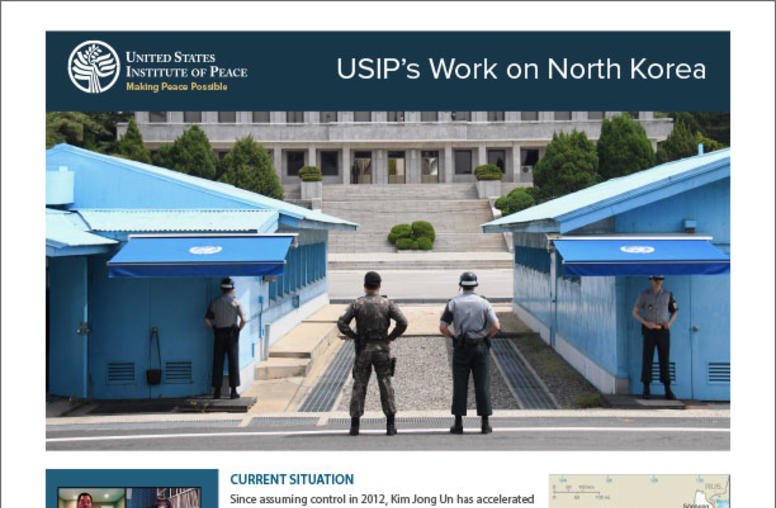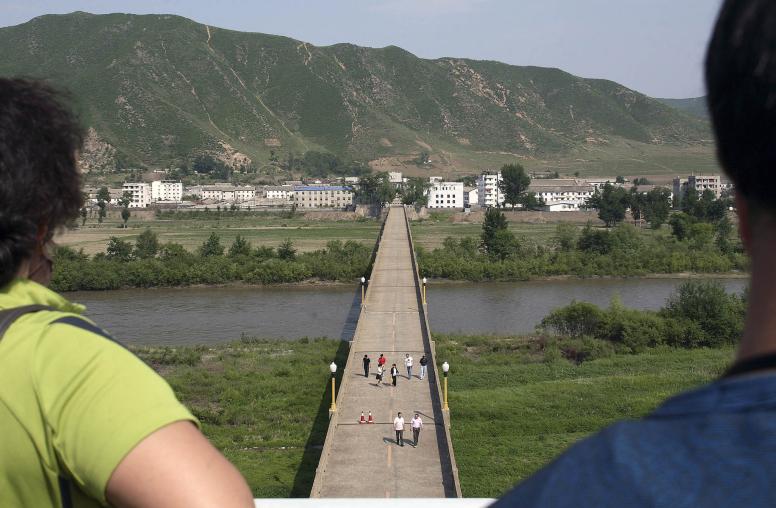After North Korea Summit, Military Cooperation Can Reduce Tensions
Follow-up by the U.S., South Korean and North Korean militaries will be a critical next step in ongoing diplomacy
As U.S. officials build on last week’s summit conference with North Korea, two notable military-related outcomes could facilitate future diplomatic negotiations and help reduce tensions on the Korean Peninsula. They are (1) the cancellation of U.S.-South Korea joint military exercises and (2) the commitment to resume the recovery of remains of U.S. service personnel from the Korean War.

In a post-summit press conference, President Trump stated that the United States “will be stopping the war games . . . unless and until we see the future negotiation is not going along like it should.” That was an apparent reference to the two major annual U.S.-South Korea joint military exercises: a springtime drill called “Key Resolve/Foal Eagle,” which combines a command-post exercise and a large field training exercise, and a late-summer command-post exercise called “Ulchi Freedom Guardian.” This week, the Department of Defense confirmed that the U.S. military would suspend this year’s Ulchi Freedom Guardian exercise as well as two Korean Marine Exchange Program (KMEP) exercises, which are medium-sized exercises that focus on enhancing combined amphibious capabilities.
Many Asia and security experts criticized this decision as risky and hasty. President Trump didn’t consult the Department of Defense or his allied counterpart, President Moon Jae-in of South Korea, before offering the cancellation. When he announced the decision, he seemed to echo North Korean talking points, calling the exercises “war games” and “very provocative.” Also, suspending exercises this early in the negotiating process without an equivalent concession from North Korea seemed like an unnecessary risk to military readiness and deterrence.
Still, providing a significant concession up front—one that North Korea has demanded over several decades—could increase the likelihood of North Korean reciprocation. Pyongyang has consistently sought an end to what it calls “hostile” U.S. policy, including a suspension of U.S.-South Korean joint military exercises, which it describes as provocative and a preparation for an invasion of the north.
There is precedent for this concession. In January 1992, the U.S.-South Korea alliance suspended a massive annual exercise, “Team Spirit.” That act led directly to Pyongyang’s signing of a nuclear safeguards agreement, which allowed international monitors to enter the country for the first time to begin inspecting nuclear facilities. Additional suspensions of the exercise in subsequent years helped create the peaceful conditions for the signing of the 1994 U.S.-North Korean Agreed Framework, which froze North Korea’s plutonium production at its Yongbyon facility for eight years.
Lingering Questions
It is unclear whether President Trump’s move will help precipitate North Korea’s complete denuclearization—a much more difficult objective today given the country’s significant nuclear development over the past 25 years. Also, additional questions remain:
- If North Korea makes satisfactory moves toward denuclearization, will President Trump also suspend the Key Resolve/Foal Eagle exercises in the spring of 2019? Since his description of “war games” as “tremendously expensive” and “very provocative” apply equally and maybe even more to the very visible Foal Eagle field training exercises, the answer likely could be yes. The suspension of major military exercises for a year will take a heavy toll on military readiness since many of the 28,500 U.S. military personnel in South Korea are on one-year rotations. And despite Vice President Pence’s assurance that “regular readiness training and training exchanges” will continue, the cancellation of the two KMEPs portend additional suspensions of smaller exercises and further risks to military readiness and interoperability. Retired U.S. Army Colonel Bill McKinney, who served as a defense attaché in Seoul and North Korea specialist at the U.S. Pacific Command, suggested ways to modify joint exercises to reduce tensions while maintaining preparedness and interoperability. These include: (1) conducting low-profile, command-post exercises for command and control training, with minimal involvement of physical troops; (2) conducting ground exercises at the division level or below; (3) relocating naval and air exercises out of sight of North Korea; and (4) minimizing publicity for all exercises.
- Will President Trump suspend routine bomber training missions from Guam and joint air exercises like Max Thunder that also irk North Korea? In addition to the suspension of major exercises, North Korea has demanded the removal of all strategic and nuclear assets from the Korean Peninsula and from military exercises. This includes training missions with B-52 bombers and F-22 stealth fighters. President Trump has not committed to suspending the participation of nuclear and strategic assets in smaller exercises, but he did criticize the costs of U.S. bomber missions that fly six-and-a-half hours “to South Korea to practice and then drop bombs all over the place, and then go back to Guam.” Potential measures for maintaining readiness while minimizing provocation could be to alter the flight paths of the training missions away from the Korean Peninsula, reduce the frequency of missions, or mute the messaging of these operations.
American Soldiers' Remains from the Korean War
The second military-related outcome from the Singapore summit that could help strengthen U.S.-North Korean relations is the bilateral commitment to recover “POW/MIA remains, including the immediate repatriation of those already identified.” From the Korean War, 7,800 American soldiers, listed as prisoners of war or missing in action, remain unaccounted for. About 5,300 are estimated to be buried in North Korea. Operations to recover their remains took place in North Korea between 1996 and 2005, but were suspended due to safety concerns and North Korea’s continued development of nuclear weapons. The two sides negotiated the resumption of operations in 2011 but this deal was scuttled when North Korea conducted a satellite launch in April 2012.
North Korea’s commitment to resume recovery operations is significant not only as a humanitarian gesture to American soldiers’ families, but as an opportunity for the U.S. military to establish better ties with the Korean People’s Army. Excavation and analysis operations would require U.S. troops to work alongside their North Korean counterparts, and could build relations and trust with one of the North Korean regime’s most influential institutions. At a minimum, these operations could give the U.S. government stronger intelligence and insight into the North Korean military.
The Singapore Summit may have been short on details and new accomplishments, but the two military-related outcomes represent an opportunity to undertake confidence-building measures. As Admiral Harry Harris, the nominee as U.S. ambassador to South Korea, said during his confirmation hearing, “I think the whole landscape has shifted and I believe that we should give exercises, major exercises, a pause to see if Kim Jong Un in fact is serious.” Careful modifications to military operations and the resumption of operations to recover remains of American troops from 65 years ago have the potential to reinforce the momentum gained in Singapore and encourage further dialogue.
Midshipman Francis Kim, a senior at the U.S. Naval Academy, is a service academy education and development fellow at USIP. The opinions presented in this article are those of the authors only and do not reflect those of the Naval Academy, the Department of the Navy, the Department of Defense, or the United States Government.



